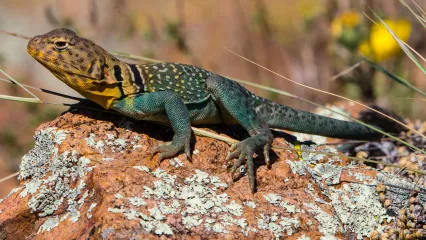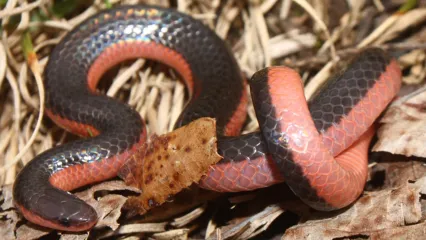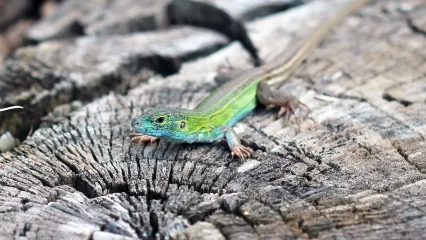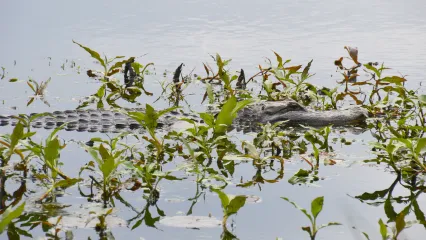
Description
The eastern collared lizard, often called the mountain boomer, is the Oklahoma state reptile. It can be easily distinguished by a combination of its relatively large size, a large head relative to the body, bright coloration, a tail twice the body length, and a distinct black collar on the neck. The collar is an irregular black line just behind the head followed by a wider and more distinct broad black marking extending from the midline of the back to the top of the front limbs. Much of the background color of adult males is green and the dorsal body surface is interrupted by faint orange markings and distinct small yellow spots. The background color of adult females is brown to gray, and depending on the breeding condition, is interrupted by bright orange elongated blotches that give the impression of wide, broken likes extending from the midline of the back to the lateral body surfaces. Yellow spots are present as in males, but not at the high density seen in males. Recently hatched juveniles have a yellow background color, collar similar to that of adults, and a series of irregular, nearly round dark blotches dispersed among series of narrower yellow to orange blotches across the dorsal body surface.
Size
Adult males can reach just over four and one-half inches in snout to vent length. Adult females are slightly smaller, reaching just over four inches in snout to vent length.
Habitat
The distribution of eastern collared lizards in North America extends from northwestern Arizona through Missouri in the east and north-south from northern Kansas to at least north-central Mexico. On a local level, they are usually found only in rocky habitats.
Life Cycle
Eastern collared lizards are active from as early as mid-March through September. Males and male-female pairs often can be seen basking on top of rocks, especially during the spring and early summer breeding season. Mating occurs from mid-April through June, a time period during which males are highly territorial. Females deposit clutches of 4-10 eggs during May through July, and some females may deposit a second clutch during that season. Similar to many other lizards in which the number of eggs varies, large females produce more eggs than smaller females. Eastern collared lizards, partly as a result of their large size, eat a combination of large insects (grasshoppers, cicadas, etc.) and small vertebrates, including other lizard species. Because male eastern collared lizards have large heads and powerful jaws, social interactions between males that result in biting have the potential to cause serious injury. Using a clever experimental protocol, Oklahoma behavioral ecologists Stanley Fox and Troy Baird demonstrated that near-neighbor territorial males were less aggressive towards each other than to unfamiliar males, a behavior known as the “dear enemy” phenomenon. Near-neighbor males recognize and tolerate each other to offset possible injuries that could result from repeated aggressive social interactions.
How To Observe
Eastern collared lizards are most easily observed by slowly driving roads where rocky outcrops occur and carefully examining the tops of boulders and fence posts. Males and male-female pairs are highly conspicuous when so perched. As a cautionary note, although not venomous, collared lizards can inflict a painful bite that usually breaks the skin of not handled carefully.
Their bright coloration and the fact they can be easily captured makes them attractive candidates for pets. Unfortunately, most do not survive in captivity. Because they are so easy to see in their own natural habitat, we recommend that interested nature lovers visit the lizards in their habitat rather than bringing them home.
(This profile was created by Dr. Laurie Vitt as part of a partnership between the Wildlife Department and the Sam Noble Oklahoma Museum of Natural History. It was funded as part of a larger State Wildlife Grant to survey and inventory amphibians and reptiles of the Wildlife Management Areas of Oklahoma: T-35-P-1.)


